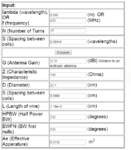luw
Newbie level 3
Hello everyone,
I am quite confused about the calculation of spring antenna (or rubber ducky antenna defined by Wikipedia). I tried with an online spring/helix antenna calculator to determine the parameters however the results do not seem like a rubber ducky antenna at all. Also, I tried to simulate a such antenna (by measuring its pitch, turns and radius etc.) with HFSS and the frequency response is far from what I desired.
The spring antenna that I am using is like this.
However, according to the online antenna calculator the size of a 433 MHz helix antenna is much larger than the one that I am using.
I hope you have already found out mistakes in my logic. I really have very limited knowledge about antennas however I want to know how to calculate and how to simulate the spring antenna that I am using.
Thanks a lot.
I am quite confused about the calculation of spring antenna (or rubber ducky antenna defined by Wikipedia). I tried with an online spring/helix antenna calculator to determine the parameters however the results do not seem like a rubber ducky antenna at all. Also, I tried to simulate a such antenna (by measuring its pitch, turns and radius etc.) with HFSS and the frequency response is far from what I desired.
The spring antenna that I am using is like this.
However, according to the online antenna calculator the size of a 433 MHz helix antenna is much larger than the one that I am using.

I hope you have already found out mistakes in my logic. I really have very limited knowledge about antennas however I want to know how to calculate and how to simulate the spring antenna that I am using.
Thanks a lot.